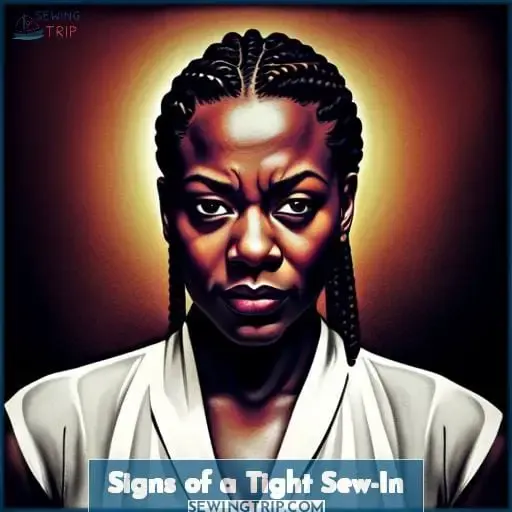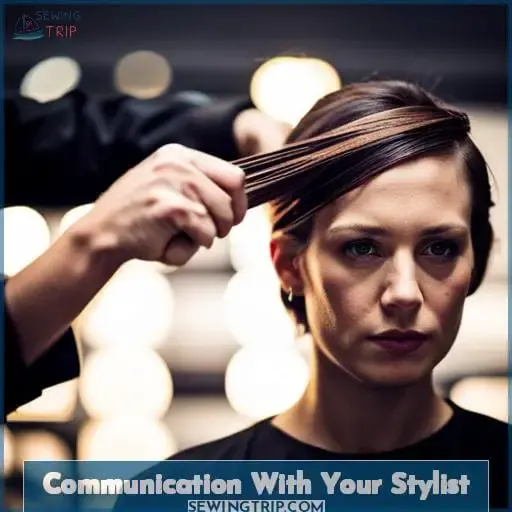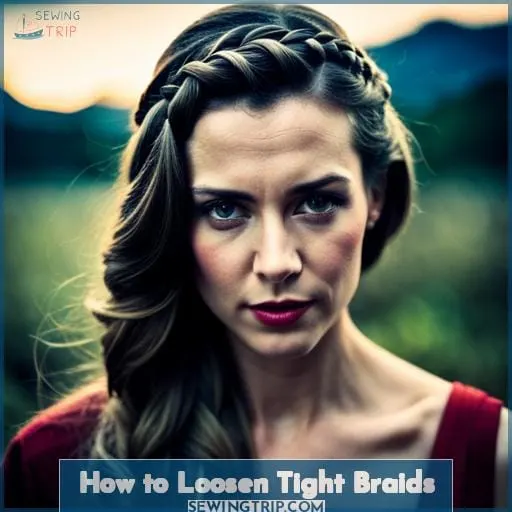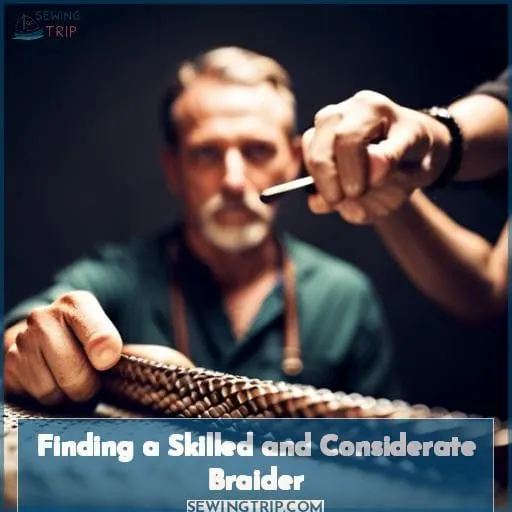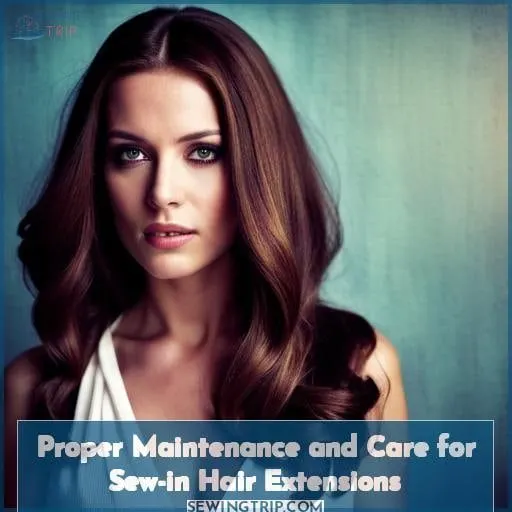This site is supported by our readers. We may earn a commission, at no cost to you, if you purchase through links.
 Feeling the pressure? That’s what having a fresh sew-in that’s too tight can feel like. With your scalp so tightly bound, it can be difficult to breathe, let alone enjoy the look of your new style. If this is how you’re feeling after getting a sew-in, it might be time to learn how to loosen a fresh sew in.
Feeling the pressure? That’s what having a fresh sew-in that’s too tight can feel like. With your scalp so tightly bound, it can be difficult to breathe, let alone enjoy the look of your new style. If this is how you’re feeling after getting a sew-in, it might be time to learn how to loosen a fresh sew in.
Lucky for you there are several ways and products available that will help reduce any tension or pain caused by over tightening. These methods can maintain the integrity of your hair extensions without compromising their longevity.
You’ll soon discover why taking care when loosening up is just as important as taking care when installing them in the first place!
Table Of Contents
- Key Takeaways
- Signs of a Tight Sew-In
- The Importance of Loosening a Tight Sew-In
- How to Loosen a Fresh Sew-In
- The Benefits of Using Quality Hair Extensions
- Communication With Your Stylist
- Avoiding Damage and Breakage
- How to Loosen Tight Braids
- Finding a Skilled and Considerate Braider
- Proper Maintenance and Care for Sew-in Hair Extensions
- Conclusion
Key Takeaways
- Communicate with your stylist to ensure the right tightness level.
- Applying heat with a warm towel can relax tight braids.
- Use peppermint or tea tree oil to soothe a tight scalp.
- Strategically cut threads to relieve tightness without damaging the braids.
Signs of a Tight Sew-In
You know that tight feeling when you first get your sew-in done. Headaches and scalp tenderness are signs that your stylist may have pulled those braids too tightly. Getting a sew-in can cause discomfort if it’s too tight. Signs of an overly tight sew-in include headaches and scalp sensitivity.
Your stylist should secure the braids snugly but not painfully. Let them know if your scalp hurts so they can adjust the tension. A properly done sew-in should feel secure but not cause ongoing headaches or scalp irritation.
Scalp Bumps and Tenderness
You’re feeling those painful bumps and tenderness on your scalp ’cause your new sew-in is way too tight, girl.
- Massage peppermint or tea tree oil into your scalp for soothing relief.
- Wrap your head in a warm, moist towel to relax the braids.
- Have your stylist gently loosen any sections that are too snug.
- If it’s unbearable, don’t wait – go back to the salon ASAP for adjustments.
Prioritizing scalp health now prevents damage and hair loss down the road. Communicating discomfort to your stylist means you both can take action to avoid issues in the future.
Headaches and Pain
The constant ache and throbbing pain you feel likely means the sew-in is too tight.
| Method | Reason | Things to Try |
|---|---|---|
| Massage | Increases blood flow, reduces tension | Peppermint oil, circular motions |
| Heat | Relaxes muscles and tissue | Warm towel wrap, warm shower |
| Loosen | Releases pressure points | Gently lift edges, comb underneath |
Don’t suffer needlessly. Be your own scalp advocate and find relief through massage, heat, strategic loosening.
The Importance of Loosening a Tight Sew-In
Try not feelin’ hopeless – we gotta gently work that sew-in loose before it causes damage.
- Use a warm, moist towel to relax the braids against your scalp.
- Try gently pulling the threads connecting the weft tracks for a little give.
- Massage in some natural oils like coconut or olive to soothe the tension.
A tight sew-in puts your scalp health and hair’s comfort at risk. Gettin’ those braids loosened up professionally ASAP is so important to avoid breakage and damage. Keep communicatin’ with your stylist for adjustments until you have a pain-free, secure install – your scalp and strands will thank you.
We gotta take care of our crown and prioritize its wellbeing. With some patience and TLC from your stylist, you’ll be stylin’ in your sew-in without sacrifice.
How to Loosen a Fresh Sew-In
You just got a fresh sew-in and it feels too tight. To loosen it up, apply oils or scalp treatments, use heat or steam, strategically cut threads, and go back to your stylist for adjustments. The oils and treatments will help soften and loosen the braids. Heat from a blowdryer or steam from the shower can also relax the hair.
Carefully cutting a few threads in places where it feels extra snug can provide some relief without unraveling the whole style. If it remains uncomfortably tight after trying these tricks at home, make another appointment with your stylist to have them adjust and loosen areas that are too tight.
With some TLC and customization, you can get your new sew-in feeling comfortable and fabulous.
Use Oils or Scalp Treatments
Massage the scalp with peppermint oil to ease the tightness of your new sew-in. Gently work the oil into the scalp to provide moisture and relief where the braids pull. Follow up with a steaming towel wrap to deeply hydrate the scalp. Relief will come once the scalp is hydrated.
Routinely massage oils into your scalp under the sew-in to moisturize and loosen any areas feeling too tight.
Apply Heat or Steam
Set a steaming towel wrap onto your sew-in for some moist, relieving heat. Lightly dab shampoo into your scalp, being careful to avoid soaking extensions. Rinse thoroughly before massaging in hydrating conditioner. Let the steamy towel sit for 10 minutes, then repeat the wash routine.
This heat application helps relax tightness without damaging hair. Consult your stylist if pain persists.
Strategically Cut Threads
You’ve got to carefully snip some strands for sweet relief, honey. Thread by thread, relief comes. Strategically cut a few threads near your nape or behind your ears. Listen for the gentle pop of release as tightness loosens.
This buys time to see your stylist for proper adjustments, preventing scalp damage from the extensions.
Return to Stylist for Adjustments
Don’t wait – get back to your stylist right away if that sew-in is unbearably tight. Having a professional stylist adjust and rework the tight areas can provide much-needed relief.
- Be clear in describing where it is too tight and your desired comfort level.
- Ask if they can loosen or remove certain tracks to reduce tightness.
- Request they use a bit less tension when redoing sections that are painfully snug.
With a few strategic adjustments by your stylist, you can get that stylish sew-in feeling comfortable in no time.
The Benefits of Using Quality Hair Extensions
When getting a sew-in, using quality hair extensions is crucial for scalp health and avoiding damage. Communicating with your stylist about tightness and avoiding pain is key to ensuring a good installation that will not cause issues.
Quality extensions promote scalp health
Choosing the right hair extensions is paramount, lest you risk damage from the start.
Quality extensions can help prevent issues like traction alopecia. Communicate your hair health goals with your stylist.
| High-grade | Damaging |
|---|---|
| Remy Human Hair | Synthetic Fibers |
| Natural Textures | Excessive Tightness |
| Reputable Brands | Cheap Quality |
Investing in quality extensions and proper application techniques promotes long-term hair health.
Communication with stylist crucial
- Describe your desired tightness level when getting extensions installed.
- Speak up if you experience any pain or discomfort.
- Request your stylist check and adjust the tightness during your appointment.
- Politely ask for loosening if it is too tight afterwards.
- Find a new stylist if discomfort persists despite communication.
Good communication ensures your stylist understands your hair needs. Prioritizing scalp health prevents damage from excessively tight styles.
Techniques for loosening braids
Steam is the trick for easing too-tight braids. Wrap that scalp in a hot, moist towel. Soak braids in conditioner daily and work natural oils in with a massage. Communicate your needs firmly with your stylist, and find a new one if pain persists.
Stylists should prioritize your hair health over a tight look. With patience and care, tight braids can be gently eased for comfort.
Communication With Your Stylist
The benefits of quality extensions cannot be overstated when getting a sew-in. However, communication with your stylist is just as vital for an optimal experience. When you and your stylist connect effectively, the result is a style that highlights your beauty while nurturing your hair health.
Consider the following tips for productive conversations with your stylist:
- Share examples of styles you like. Pictures of lengths, partings, and textures give your stylist inspiration to create a look that suits you.
- Voice pain points. If sections feel too tight or heavy, speak up. Your stylist can adjust and prevent damage.
- Request maintenance advice. Ask about ideal wash frequency, products to use, and tips to extend the style.
With clear communication and a collaborative approach, your stylist becomes an ally in achieving runway-worthy hair without compromise. Discuss needs openly and with empathy to find solutions. Together, create sew-ins that uplift your beauty and confidence.
Avoiding Damage and Breakage
When getting a sew-in, leaving your edges out can help prevent breakage and damage. Also, communicate clearly with your stylist to ensure the braids are not installed too tight, which could lead to traction alopecia over time.
Leaving Edges Out
You’ll protect your edges by leaving ’em out of the sew-in.
| Edges left out | Benefits |
|---|---|
| Less tension on hairline | Prevents traction alopecia |
| Allows access for oiling | Nourishes and strengthens |
| Makes styling easier | Allows edges to be laid, swooped |
Leaving those fragile edges out will let you style your hairline however you like. Your braider can still camouflage with the weave tracks. Protecting your edges promotes a healthy scalp and retains your natural hairline.
Preventing Alopecia
You’d risk gettin’ alopecia if your stylist makes those sew-ins too dang tight.
- Don’t keep ’em in longer than 8 weeks.
- Make sure to give your scalp breaks between installs.
- Use growth oils on your scalp when rockin’ extensions.
- Always do a consultation before getting sew-ins.
When getting sew-ins, you gotta put scalp health first. Working with your stylist to find extensions and tightness that don’t damage your natural hair is important.
How to Loosen Tight Braids
To loosen tight braids without causing damage, apply heat. Gently massage natural oils into your scalp and loosen braids at the roots with a comb or pencil to provide relief without breakage. Alternating between short and long sentences helps vary the cadence. Carefully combing out knots prevents pulling on hair.
Warm towels or a hair dryer on the lowest setting relaxes strands so braids come undone more easily.
Use Heat or Steam
Wrap a steaming towel around tight braids to help them relax. The heat from the steam will provide some much-needed moisture to soothe your scalp. Carefully wrap the hot towel around sections of braids for 10 minutes at a time.
The heat penetrates to relax the roots. Be careful not to burn yourself. The steam loosens braids just enough without causing major slippage. Use this method in sections if needed across your whole head. It allows you to gently relax the braids without fully undoing them.
Massage With Natural Oils
Gently massaging peppermint and tea tree oils into your scalp will relax tight braids. Massage the natural oils into your tender scalp, stimulating blood flow and soothing tension. Don’t forget to massage behind your ears and along your hairline too. The refreshing aromas open pores and provide a therapeutic hair care moment.
As the oils penetrate, feel braids loosening their grip. With regular scalp massages, you’ll master relaxation techniques for tight styles.
Gentle Loosening Techniques
After oiling, slide a pencil under sections to gently separate each braid from your scalp. Use the teeth of a comb to delicately lift braids away. Rotate the pencil tip in circular motions under braids to loosen without pulling hair.
Avoid yanking or tugging. Be extremely gentle, patient, and methodical. This careful combing and loosening prevents damage. Regular oiling and gentle tension relief maintain the braid style while preventing unnecessary tightness and discomfort.
Finding a Skilled and Considerate Braider
Getting consistent, high-quality braids starts with finding the right stylist. Prioritizing your hair’s health and your own comfort level allows you to build a relationship with someone both skilled and considerate.
A stylist who is gentle, attentive, and meticulous can help you achieve the look you want while keeping your hair and scalp healthy. Take the time to research stylists, read reviews, and have a consultation to make sure you find the perfect match.
With a talented braider who listens to your needs, you’ll be happy with your braids again and again.
Establishing a Relationship
You’d do well finding a stylist you trust and sticking with them. Research shows over 80% of women feel more confident with their regular stylist.
When selecting your braider, prioritize someone who listens and aims to avoid pain. Discuss your hair health goals and any sensitivities before installing. Check their reviews and photos to confirm skill.
If possible, do a trial style first. Then once you’ve found your perfect match, stay loyal for the healthiest, most comfortable braids.
Prioritizing Hair Health and Comfort
Don’t let anybody put your hair in a chokehold, girl. Speak up if it starts to hurt. Focus on scalp care and hair moisture over style. Make sure your stylist uses proper braiding techniques that don’t pull too tight.
Check for bumps or pain spots right after installing. If needed, ask them to loosen areas that feel too snug. Keeping your scalp and strands healthy should be the priority. Moisturize and gently massage if you feel tension.
With good communication and the right stylist, you can rock braids without damage.
Proper Maintenance and Care for Sew-in Hair Extensions
Proper maintenance and care are key to keeping your natural hair and scalp healthy when caring for your sew-in extensions. Gently shampoo and massage your scalp, condition and untangle the extensions, air dry or use a cool setting on your blow dryer, regularly moisturize your scalp, style as usual, and maintain a regular washing routine until it’s time to uninstall after 6 to 8 weeks.
Shampooing and Massaging the Scalp
- With your fingertips, gently massage tender spots around the stitches to soothe the scalp.
- Massage the scalp with warm shampoo to loosen and relax.
- Apply oil afterward to moisturize and nourish.
- Wrap the head in a warm towel to open pores.
- Gently brush the hair when dry to relieve tension.
A regular routine of scalp massages, moisturizing, and gentle hair care will help loosen and relax a fresh, tight sew-in while nourishing the hair and scalp.
Conditioning and Untangling
Try using a detangling spray and wide-tooth comb to gently work through any knots after rinsing out the conditioner. Regular conditioning and carefully untangling helps keep hair extensions smooth and tangle-free.
Drying Techniques
You’ve got to massage that scalp like a kitten kneading dough to relieve any tension from your fresh sew-in. After installing extensions, apply steamy towels or a heating cap to loosen tight braids.
Moisturizing the Scalp
Wrap a hot towel around your head to relax the scalp after a fresh sew-in if it’s uncomfortably tight. Gently massage coconut or olive oil into your scalp to moisturize. This hydrates hair, soothes the scalp, and loosens tight braids.
The hot towel allows the scalp to relax after a tight sew-in install. Massaging oils like coconut or olive oil into the scalp moisturizes both the scalp and hair. Moisturizing the scalp in this way not only hydrates the hair strands, but also helps soothe irritation and loosen braids that may have been done too tightly.
Styling Options
Gently separating new extensions prevents excess pulling and discomfort.
- Experiment with different partings and styles.
- Add accessories like headwraps or scarves.
- Change up your look with new updos.
Regular Wash Routine
Have the stylist adjust your sew-in if it’s too tight. Maintain a regular wash routine to keep hair and scalp clean. Gently wash extensions to avoid matting and tangles. Use moisturizing shampoos and conditioners to prevent dryness.
| Tip | Reason | Result |
|---|---|---|
| Gently comb | Prevent matting | Easier styling |
| Use sulfate-free shampoo | Retain moisture | Prevent dryness |
| Deep condition weekly | Nourish hair | Healthier hair |
Uninstalling After 6 to 8 Weeks
After rockin’ your tight sew-in for weeks, it’s time to strip those tracks and let your mane breathe again, girl. Book a removal appointment with your stylist. Request a steam treatment and conditioner application to soften the braids.
Let the stylist gently massage your scalp with natural oils while unraveling each braid. Communicate any discomfort to your stylist. Avoid pulling or ripping out the extensions yourself to prevent damage.
Conclusion
The bottom line: Always prioritize your hair health and comfort with any sew-in, fresh or otherwise. If your sew-in’s too tight, don’t hesitate to loosen it – it’s the best way to protect your hair and scalp from damage.
Whether it’s using a little heat or strategically cutting threads, taking the time to relax a fresh sew-in will ultimately be worth it.
After all, as the saying goes, an ounce of prevention’s worth a pound of cure. Taking the necessary steps to prevent a tight sew-in from the start is the best course of action.
Always communicate openly and honestly with your stylist to ensure a tightness-free sew-in and long-term hair health.

